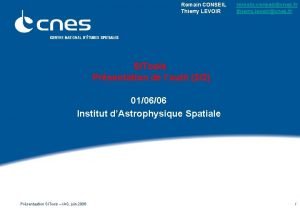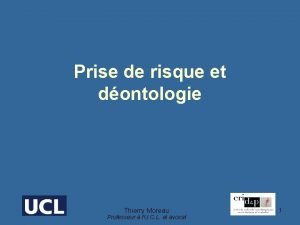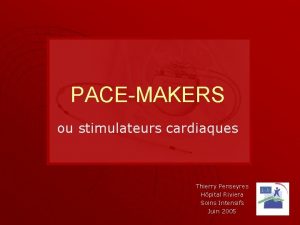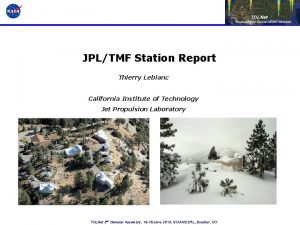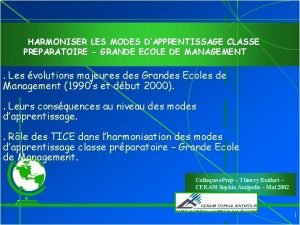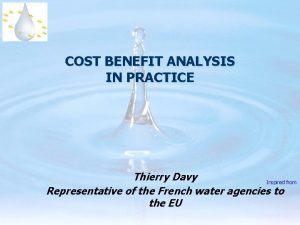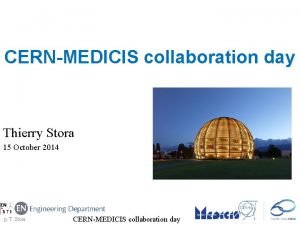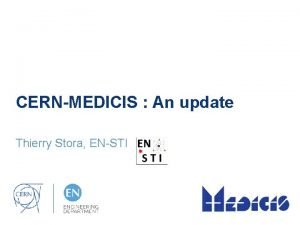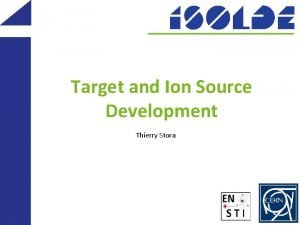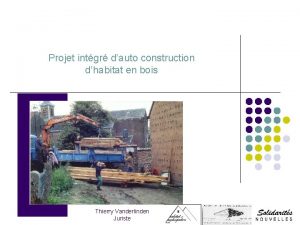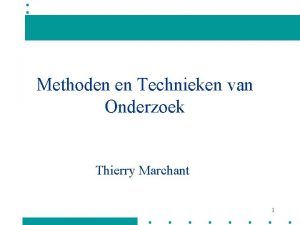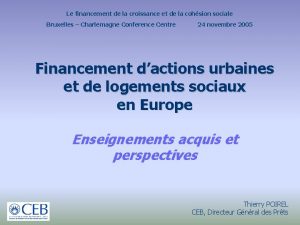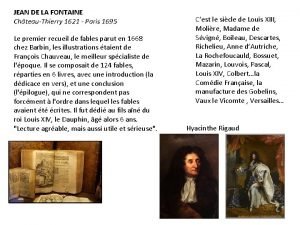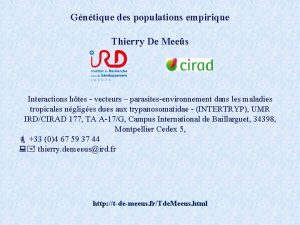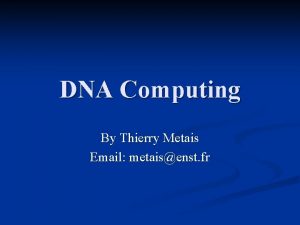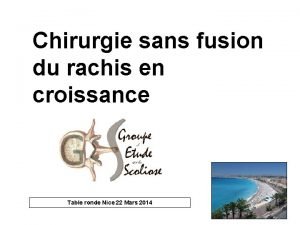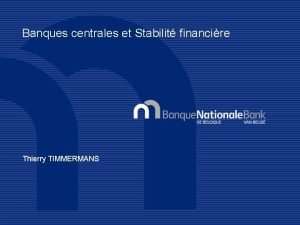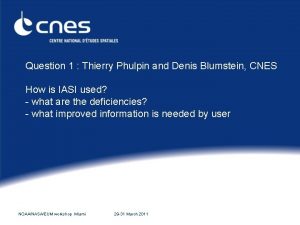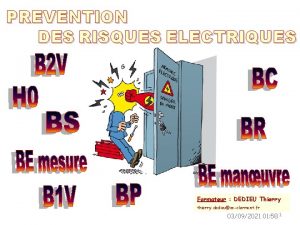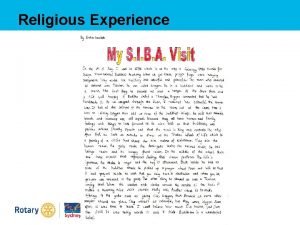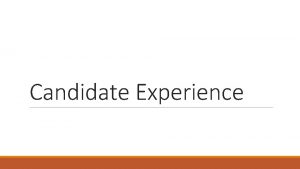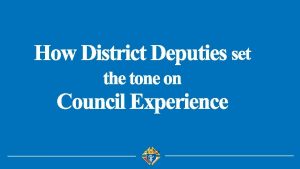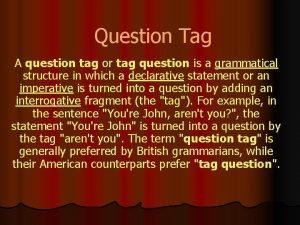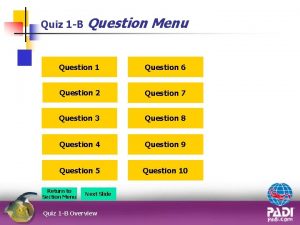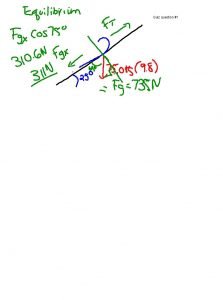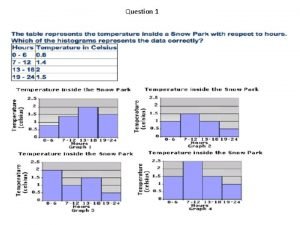Question 3 Thierry Phulpin Experience with use of





















- Slides: 21

Question 3: Thierry Phulpin Experience with use of IASI on Metop A and plans Thierry Phulpin CNES project scientist for IASI and IASI-NG NOAA/NASA/ EUMETSAT Miami 29 -31 March 2011 1

Preamble ■ This is a point of view through the work of the ISSWG and the lessons learnt from recent symposia among them the 2 nd IASI international conference ■ ISSWG played a strong role to develop applications (role and activities recalled orally) ■ Recall of National french (CNES) support to scientific activities around IASI NOAA/NASA/EUM Workshop Miami, 29 -31 March 2011 2

Applications of IASI data Operational meteorology (1) Global NWP, LAM, mesoscale models w Number of users, different methods but generally based on level 1 c products, · Only 1 pixel/4 (except mesoscale) every two FOR, only less than 200 channels w Still in development : more conditions (clouds) more areas (polar regions). More channels (Humidity : band 2). In a short term use of PCAs NOAA/NASA/EUM Workshop Miami, 29 -31 March 2011 3

Operational meteorology (2) ■ Very good results have been obtained : quantified to about 3 hours at 3 days w Illustrations with Klaus and Arome ■ However open questions: w Will more channels be treated in future (band 3)? w Will more pixels be used ? w Will the inhomogeneous pixels be used? ■ Remaining issues: w Humidity profile (even if recent progress) w Spectroscopy (improvements still needed to fully exploit IASI data) ■ Remark w Level 2 products are rarely used. NOAA/NASA/EUM Workshop Miami, 29 -31 March 2011 4

Climate ■ GSICS ■ Beginning archiving level 2 products ■ Some IASI products will be used in confrontation with Climate models (Ozone, clouds) ■ Some products used for monitoring : Profiles, aerosols, CO 2, CH 4, clouds, etc. (see C. C talk) ■ Only a few climate process studies make use of IASI data Quality is there (accuracy, stability, etc. ) Just need to foster scientific plans NOAA/NASA/EUM Workshop Miami, 29 -31 March 2011 5

NOAA/NASA/ EUMETSAT Miami 29 -31 March 2011 6

Atmospheric chemistry ■ More than 20 species (in fires) detected ■ Some well quantified : O 3 (TC and profile), CO, CH 4, CO 2 ■ Some only detected but with avery high reliability : SO 2, HNO 3, NH 3, Formic acid, methanol ■ Operational applications : MACC (CO), VAAC (SO 2) NOAA/NASA/EUM Workshop Miami, 29 -31 March 2011 7

Russian fires 2010 CO total column measurements derived from the IASI/Met. Op observations from July 22 to August 22, 2010. These data are averaged over 3 days on a 0. 5°x 0. 5° grid and only daytime concentrations above 2. 2 x 18 molecules/cm 2 are shown. Please give credit for this animation to Maya George (LATMOS)

Species observed globally with IASI Clerbaux et al. , ACP, 2009, and references therein

Species observed locally with IASI after a volcanic eruption (here, at Kasatochi, in August 2008) in plumes of biomass burning (here, for the 2009 Australian bushfires) Clarisse et al. , submitted to GRL, 2011

Lessons learned for AC ■ All spectrum very useful ■ Other atmospheric data mandatory (cloud, temperature, humidity) ■ Large swath => Very good coverage. ■ Stability is very important. ■ Improve Ne. DT and Spectral resolution would help to detect and quantify more species and also obtain profiles. NOAA/NASA/EUM Workshop Miami, 29 -31 March 2011 11

Issues ■ No convincing products : N 2 O ■ Impact of potential restriction of distributing PCAs only? ■ CO 2 limited to UTLS ■ Most of products good in upper troposphere but of coarser quality in lower troposphere or BL (e. g. O 3, CO) hampering strong develpment of AQ applications ■ Develop combined assimilation of AC and NWP encouraging results in MACC)( NOAA/NASA/EUM Workshop Miami, 29 -31 March 2011 12

Current budget X X x X X ? XXX X X NOAA/NASA/EUM Workshop Miami, 29 -31 March 2011 13

Requirements for IASI-NG (1) ■ Based on PMET position papers, S 5 requirements and MENINGE (french scientific community) ■ Improvement of atmospheric profiles (Temp, H 2 O). Especially over land, near surface ■ Extension to cloudy conditions ■ Combine AC and NWP? ■ Many species to be measured, more to be detected Note for Eumetsat The main users of the IRS mission will be the WMO real time users, i. e. NWP centres of National Meteorological Services and ECMWF. Operational nowcasting services of National Meteorological Services may also be users of the IRS mission. The IRS mission is also relevant to non real-time users, such as for climate monitoring and atmospheric chemistry. NOAA/NASA/EUM Workshop Miami, 29 -31 March 2011 14

Requirements for IASI-NG (2) ■ Clear advantage in reducing the Radiometric noise. ■ Advantage presumed of improved spectral resolution for AC. To be consolidated. Is there one for NWP? ■ Advantage of spatial resolution and sampling? 5. 1. 3 Priority of Requirements - MRD_IRS. 005 1. Spectral and radiometric resolution shall have priority over spatial sampling distance as long as the spatial sample equivalent diameter is less than the specified threshold value. 2. Spectral resolution shall have priority over radiometric resolution for the atmospheric chemistry application as long as the threshold values are not exceeded. 3. Radiometric resolution shall have priority over spectral resolution for the NWP application. NOAA/NASA/EUM Workshop Miami, 29 -31 March 2011 15

STUDIES TO JUSTIFY REQUIREMENTS ■ TWO rounds : CNES and then scientific studies carried out by MENINGE ■ Main results : Resolution/2 and radiometric noise /2 > w Better acccuracy of T(z) in near surface layers w More information on CO and CH 4 w Slight improvement on H 2 O (? ) NOAA/NASA/EUM Workshop Miami, 29 -31 March 2011 16

NWP Temperature profile sounding ■ Profile retrieval using the 15 µm and 4 µm CO 2 bands ■ Tropical atmosphere ■ Noise contribution from uncertainties on surface temperature and emissivity, humidity profile. ■ A priori covariance from ECMWF ■ With respect to a priori uncertainty, IRS 2 contribution is about twice IRS 1 contribution NOAA/NASA/EUM Workshop Miami, 29 -31 March 2011 DOFS = 5. 9 DOFS = 10. 7 17

NWP Temperature profile sounding : effect of spectral resolution IRS 1 Spectral noise res. IRS 2 IRS 1 contribution IRS 2 contribution NOAA/NASA/EUM Workshop Miami, 29 -31 March 2011 Noise Spectral resolution IASI/2 IASI/(2 2) IASI/2 ■ The relative gain (or error reduction) is defined as (a posteriori-a priori)/(a priori) ■ It is in the range 5 - 25%. ■ Spectral resolution improves the instrument contribution, beyond noise reduction by increasing the number of channels ( n) 18

Atmospheric chemistry : CO profile (2140 -2180 cm-1) MRD thresh old MRD breakthrou gh IRS 1 IRS 2 A reference IRS 2 H cold bench Spectral resolution (cm-1) 0. 15 0. 1 0. 5 0. 25 Spectral sampling (cm-1) 0. 124 0. 083 0. 25 0. 125 Ne. DT (K) 0. 15 0. 1 0. 28 0. 16 0. 12 DOFS 2. 84 3. 78 1. 88 2. 51 2. 69 Tropospheric column (0 -12 km) (%) 2. 14 1. 95 3. 39 2. 24 2. 15 Boundary layer (0 -3 km) (%) 10. 2 7. 8 16. 05 10. 7 10. 1 IRS 1 instrument is not sufficient to provide a vertical profile (less than 2 DOFS). IRS 2, though not meeting the level 1 requirements, is close to the threshold level 2 performances (especially for the cold bench configuration). NOAA/NASA/EUM Workshop Miami, 29 -31 March 2011 19

Atmospheric chemistry : CH 4 column (1280 -1360 cm-1) MRD threshold MRD IRS 1 breakthrough IRS 2 Spectral resolution (cm-1) 0. 3 0. 15 0. 4 0. 2 Spectral sampling (cm-1) 0. 248 0. 124 0. 25 0. 125 Ne. DT (K) 0. 2 0. 1 0. 05 Total column (%) 13. 1 6. 9 9. 9 4. 6 ■ The CH 4 column can be retrieved with a precision in agreement with the MRD threshold (resp. breakthrough) from IRS 1 (resp. IRS 2) observations. NOAA/NASA/EUM Workshop Miami, 29 -31 March 2011 20

NOAA/NASA/EUM Workshop Miami, 29 -31 March 2011 21
 What is a costa level 3 question
What is a costa level 3 question Imprint definition psychology
Imprint definition psychology Continuity vs discontinuity
Continuity vs discontinuity Direct and indirect experience
Direct and indirect experience Thierry levoir
Thierry levoir Thierry moreau ucl
Thierry moreau ucl Pace endoveineux
Pace endoveineux Thierry duliere
Thierry duliere Thierry leblanc
Thierry leblanc Thierry boidart
Thierry boidart Thierry davy
Thierry davy Thierry stora
Thierry stora Ensti
Ensti Thierry stora
Thierry stora Thierry vanderlinden
Thierry vanderlinden Thierry marchant
Thierry marchant Thierry poirel ceb
Thierry poirel ceb Chateau thierry
Chateau thierry Logiciel baps
Logiciel baps Thierry metais
Thierry metais Alain thierry montpellier
Alain thierry montpellier Thierry timmermans
Thierry timmermans




